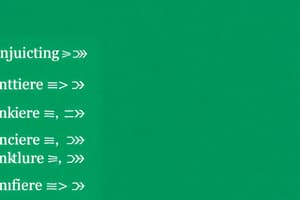Podcast
Questions and Answers
Wat is die funksie van 'n konjunksie in 'n sin?
Wat is die funksie van 'n konjunksie in 'n sin?
- Om woorde, frase of klause te verbind (correct)
- Om 'n sin te beëindig
- Om woorde, frase of klause te skei
- Om 'n sin te begin
Waar word 'n subordinerende konjunksie gebruik?
Waar word 'n subordinerende konjunksie gebruik?
- Om twee onafhanklike klause te verbind
- Om 'n afhanklike klause aan 'n onafhanklike klause te verbind (correct)
- Om 'n sin te verleng
- Om 'n sin te verkort
Waar word 'n additiewe konjunksie gebruik?
Waar word 'n additiewe konjunksie gebruik?
- Om woorde of frase te verbind met gelyke belangrikheid (correct)
- Om woorde of frase te verbind met verskillende belangrikheid
- Om woorde of frase te skei
- Om woorde of frase te verbind sonder belangrikheid
Wat is die naam van die konjunksie wat woorde of frase verbind wat met mekaar in teenstelling is?
Wat is die naam van die konjunksie wat woorde of frase verbind wat met mekaar in teenstelling is?
Waar word 'n kausale konjunksie gebruik?
Waar word 'n kausale konjunksie gebruik?
Waar word 'n kondisionele konjunksie gebruik?
Waar word 'n kondisionele konjunksie gebruik?
Flashcards are hidden until you start studying
Study Notes
Definition and Function
- A conjunction is a word that connects two words, phrases, or clauses together in a sentence.
- Conjunctions help to link ideas, show relationships, and provide coherence to sentences.
Types of Conjunctions
- Coordinating Conjunctions: connect words, phrases, or clauses of equal importance
- Examples: and, but, or, nor, for, so, yet
- Subordinating Conjunctions: connect a dependent clause to an independent clause
- Examples: because, since, after, although, though, unless, until
Coordinating Conjunctions
- Additive: connect words or phrases of equal importance
- Example: I like reading books and watching movies.
- Adversative: connect words or phrases that contrast with each other
- Example: I wanted to go to the beach, but it was raining.
- Causal: connect words or phrases showing cause and effect
- Example: I'm tired, so I'm going to bed.
- Temporal: connect words or phrases showing time relationships
- Example: I'll meet you at 5, and we'll go to the concert.
Subordinating Conjunctions
- Introduce dependent clauses, which cannot stand alone as a complete sentence
- Causal: show cause and effect
- Example: I'm tired because I didn't sleep well.
- Temporal: show time relationships
- Example: I'll meet you at 5, after I finish my work.
- Conditional: show conditions or hypotheses
- Example: If it rains, I'll take an umbrella.
- Concessive: show contrast or unexpectedness
- Example: Although I'm tired, I'll stay up to finish the project.
Using Conjunctions Correctly
- Use a comma before a coordinating conjunction when connecting two independent clauses
- Do not use a comma before a subordinating conjunction
- Use a semicolon before a coordinating conjunction when connecting two independent clauses that already contain commas
Konjunksies: Definisie en Funksie
- 'n Konjunksie is 'n woord wat twee woorde, frase, of klousules aanmekaar verbind in 'n sin.
- Konjunksies help om idees te verbind, verwantskappe te toon, en koherensie aan sinnings te gee.
Tipes van Konjunksies
- Koordinerende Konjunksies: verbind woorde, frase, of klousules van gelyke belangrikheid
- Voorbeelde: en, maar, of, ner, vir, so, nog
- Subordinerende Konjunksies: verbind 'n afhanklike klousula aan 'n onafhanklike klousula
- Voorbeelde: omdat, sedert, nadat, alhoewel, hoewel, tensy, totdat
Koordinerende Konjunksies
- Additief: verbind woorde of frase van gelyke belangrikheid
- Voorbeeld: Ek hou van lees en kyk TV.
- Adversatief: verbind woorde of frase wat teenoor mekaar kontrasteer
- Voorbeeld: Ek wou na die strand gaan, maar dit het gereën.
- Kausal: verbind woorde of frase wat oorsaak en gevolg toon
- Voorbeeld: Ek is moeg, so ek gaan lê.
- Temporeel: verbind woorde of frase wat tydverwantskappe toon
- Voorbeeld: Ek sal jou ontmoet om 5, en ons sal na die konsert gaan.
Subordinerende Konjunksies
- Kausal: toon oorsaak en gevolg
- Voorbeeld: Ek is moeg omdat ek nie goed geslaap het nie.
- Temporeel: toon tydverwantskappe
- Voorbeeld: Ek sal jou ontmoet om 5, nadat ek my werk klaar het.
- Kondisionaal: toon voorwaardes of hipoteses
- Voorbeeld: As dit reën, sal ek 'n umbrel neem.
- Konsessief: toon kontras of onverwagsheid
- Voorbeeld: Alhoewel ek moeg is, sal ek bly om die projek te voltooi.
Die Korrekte Gebruik van Konjunksies
- Gebruik 'n komma voor 'n koordinerende konjunksie wanneer twee onafhanklike klousules verbind word.
- Gebruik geen komma voor 'n subordinerende konjunksie nie.
- Gebruik 'n semikoolon voor 'n koordinerende konjunksie wanneer twee onafhanklike klousules wat reeds kommas bevat, verbind word.
Studying That Suits You
Use AI to generate personalized quizzes and flashcards to suit your learning preferences.




